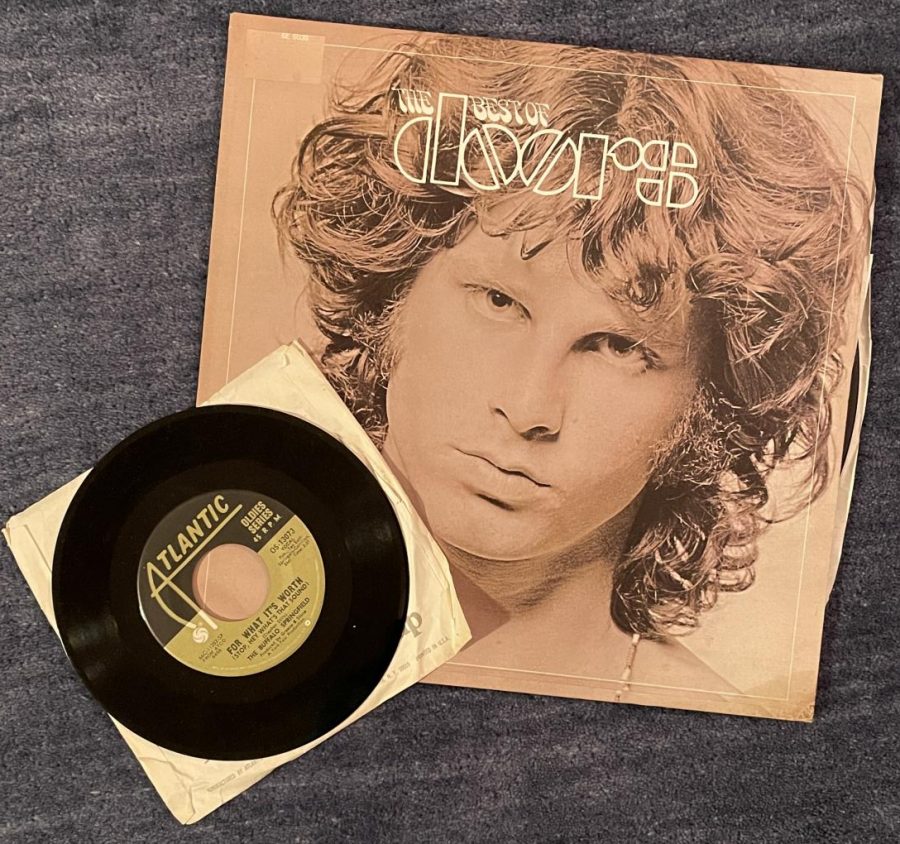Fifty Years Later, the Songs Remain the Same, But We’ve Stopped Listening to Them
1971 was a game changing year in the music world, so why have we stopped listening to some of the albums that shaped music today?
The author is particularly proud of this original 1973 pressing of “The Best of The Doors” which she purchased while walking down Columbus Avenue, and this Buffalo Springfield 45 pressing of their hit song ‘For What It’s Worth.’
How do we determine what is worth remembering? For Shakespeare and Saint-Saëns, Debussy and Dostoyevsky, it is in their work. It is still performed and read, dissected and celebrated centuries after they passed. The problem is that art, in its many forms, has lost its inherent permanence. We must put in the effort to remember it. 2021 marks a significant anniversary in music history, as some of the (arguably) most influential albums in rock, folk, and soul music history were released fifty years ago, but despite their importance, we risk forgetting them already.
The most famous example has to be that of Led Zeppelin, who released their fourth album on November 8th, 1971, changing rock music forever. Critics will forever speak in raptures about the British band’s untitled album, lauded for its cohesiveness despite the juxtaposition of early-Zeppelinesque tracks like “Black Dog” and “Rock and Roll” with more soulful numbers such as “When the Levee Breaks” and pretty acoustic arrangements like “Going to California.” These songs alone should place the album in the hallowed halls of rock music history, and that is without mentioning the most famous rock and roll song (and most overplayed tune in every guitar store on the planet) of all time, “Stairway to Heaven.” If any doubts lingered about Led Zeppelin’s greatness, this album dispelled them.
Another album that successfully banished doubts was Marvin Gaye’s “What’s Goin’ On,” which featured poignant statements on issues such as class and race through songs like “Inner City Blues (Make Me Wanna Holler)” and environmental advocacy through the soulful “Mercy Mercy Me (The Ecology)”, all while proving Gaye’s talent as a songwriter and artist outside the realm of Motown.
In an average year, one cannot expect more than two or three truly fantastic albums to emerge, but 1971 was anything but average. I would be remiss to leave out Joni Mitchell’s fourth album, “Blue,” which features some of her best known and critically lauded tracks like “Blue,” “Carey,” “California,” “Little Green,” and “River.”
Combining Mitchell’s folk-music talents and Gaye’s success post-Motown was Carole King, who released her solo album “Tapestry” in 1971. Tracks include “I Feel The Earth Move” and “It’s Too Late,” as well as covers of songs that King originally penned for Motown acts, such as The Shirelles’ “Will You Love Me Tomorrow?” and Aretha Franklin’s “(You Make Me Feel Like) A Natural Woman,” recorded at the urging of King’s good friend and folk-rock legend, James Taylor. In fact, Taylor, along with Joni Mitchell, sang backup on most of “Tapestry’s” songs.
Marvin Gaye and Carole King’s albums may have been the strongest overall, but 1971 marked a new start for many artists. David Bowie released “Hunky Dory,” widely considered to be a sign that Bowie had found his foothold, immortalized in the song “Changes.” Bands like The Who and the Rolling Stones had similar successes to Led Zeppelin, the former’s fifth album, “Who’s Next” has been called their best by many critics, and the latter’s eleventh, “Sticky Fingers” has been called one of their best, as well as their last great record.
As a matter of personal preference, I believe that the most important record released in 1971 was Pink Floyd’s “Meddle.” Not only was Meddle a marked shift towards the more psychedelic music that Pink Floyd is best known for, but it is also the symbol of a band trying to find their sound after the departure of founding member Syd Barrett due to mental illness. As a longtime Pink Floyd fan, I truly believe that the creative struggles the band went through to write Meddle were directly conducive to the success they found with albums like The Dark Side of the Moon (1973) and Wish You Were Here (1975).
It is worth mentioning that 1971 had not begun on a particularly auspicious note. On September 18th, 1970, Jimi Hendrix died at the age of 27 in London, and less than three weeks later on October 4th, Janis Joplin died in Hollywood, also at the age of 27. The loss of two rock n’ roll powerhouses in such a short time frame was crushing, and it was only compounded by the loss of the Doors’ frontman Jim Morrison on July 3rd, 1971, also at the age of 27, exactly two years after Rolling Stones founder Brian Jones died aged 27. Not until Nirvana frontman Kurt Cobain’s death in 1994 at the same age was the idea of ‘The 27 Club’ first postulated, but the unfortunate group has since grown to include actor Anton Yelchin, singer-songwriter Amy Winehouse, and visual artist Jean-Michel Basquiat.
We cannot stop listening to these albums, especially since they paved the way for so many of the musicians of the last fifty years, and will continue to inspire in the future.
Art, in its many forms, has lost its inherent permanence.
Maanya Shah is an Arts and Entertainment Editor for ‘The Science Survey.' She finds that journalistic writing is the perfect way to balance creative...











